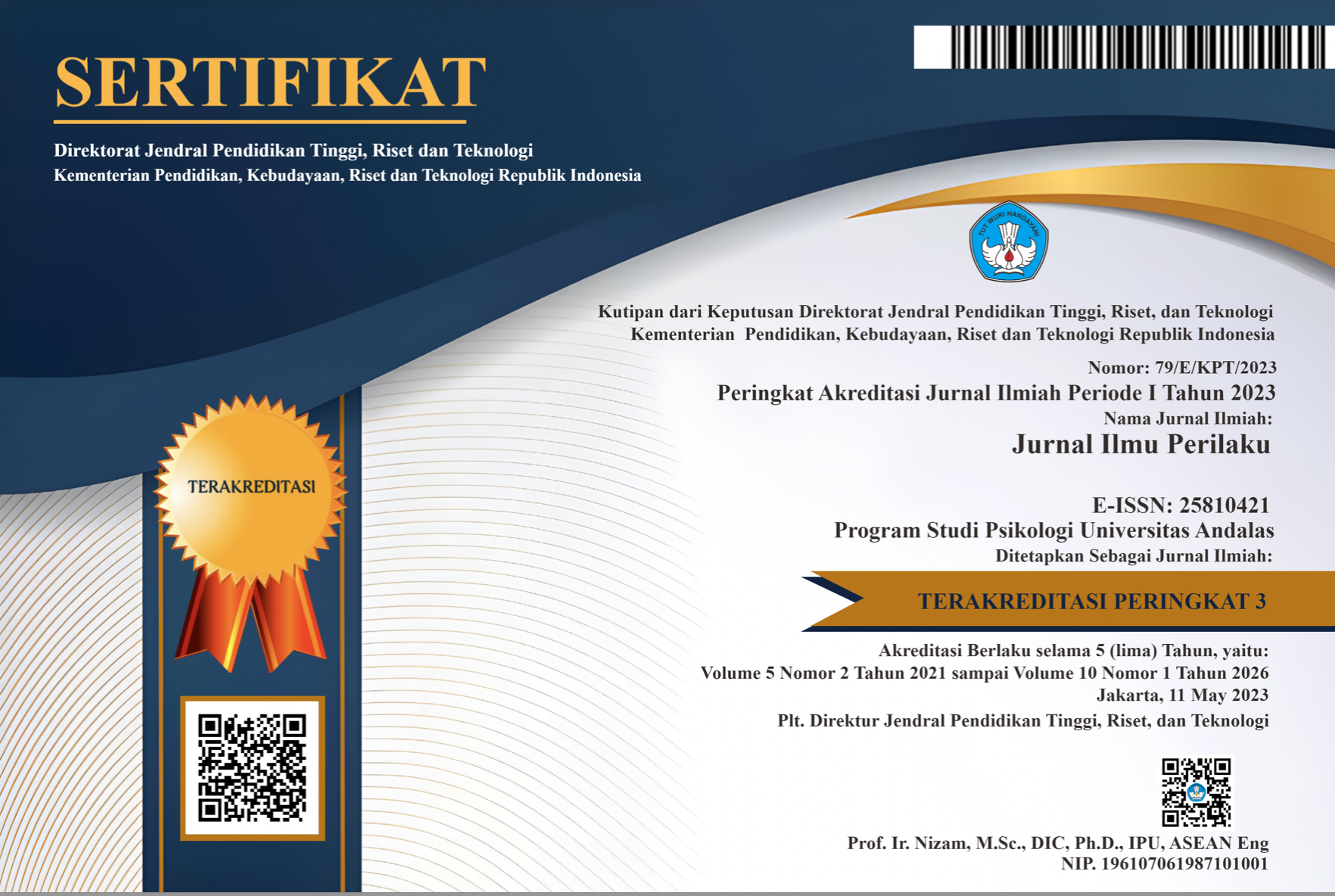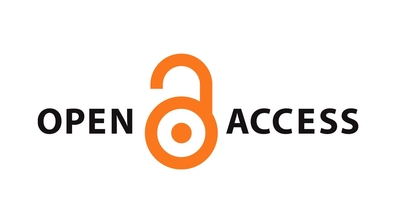Perilaku Cyberbullying pada Remaja Ditinjau Dari Empati dan Regulasi Emosi
Abstract
The development of information technology, especially the internet, has many positive impacts, but of the many positive impacts, there are several negative impacts, one of which is cyberbullying. Teenagers are the most active social media users in Indonesia and are prone to cyberbullying behavior. There are several factors that cause adolescents to commit cyberbullying, including empathy and the ability to regulate emotions. This study aims to look at the influence of empathy and emotion regulation on adolescent cyberbullying behavior. The subjects in this study amounted to 137 adolescents with characteristics aged 18-25 years, actively using social media, having committed acts of cyberbullying in the last 6 months (such as writing comments using harsh and angry words to others, uploading photos or videos of other people's disgrace (embarrassing) without permission, ostracizing someone in online group activities, and the like). Data collection was carried out by distributing questionnaires via google form. The data analysis technique uses multiple regression. The results revealed that there was an effect of empathy and emotion regulation together on cyberbullying behavior by 7.2% with a sig. value 0,007. Separately, empathy has a negative influence of 27% with a sig. value 0.002 on cyberbullying behavior while emotional regulation has no effect on cyberbullying behavior with a sig. value 0.526. Therefore, it is important to conduct empathy training so that adolescents can increase their empathy to prevent cyberbullying.
Downloads
References
Ambarita, S. (2017). Berkembangnya media sosial di zaman sekarang. Diakses pada 1 November 2019 dari https://www.kompasiana.com/siscaasniswati/596dcee7f7/afdd78457c52e2/berkembangnya –media-sosial-di-jaman-sekarang?page=all.
Arianti, R. (2018). Pengaruh konformitas dan regulasi emosi terhadap perilaku cyberbullying. Psikoborneo, Volume 6, No.4, 505-512. http://dx.doi.org/10.30872/psikoborneo.v6i4.4672.
Azwar, S. (2015). Penyusunan skala psikologi edisi 2. Yogyakarta: Pustaka Belajar.
Azwar, S. (2016). Metode penelitian. Yogyakarta: Pustaka Pelajar.
Baroncelli, A., & Ciucci, E. (2014). Unique effects of different components of trait emotional intelligence in traditional bullying and cyberbullying. Journal of adolescence, 37(6), 807–815. https://doi.org/10.1016/j.adolescence.2014.05.009.
Baron-Cohen, S., & Wheelwright, S. (2004). The empathy quotient: An investigation of adults with asperger syndrome or high functioning autism, and normal sex differences. Journal of Autism and Developmental Disorders, 34, 163-175.
https://doi.org/10.1023/B:JADD.0000022607.19833.00.
Blanchard-Fields, F., Stein, R., & Watson, T. L. (2004). Age differences in emotion-regulation strategies in handling everyday problems. The journals of gerontology. Series B, Psychological sciences and social sciences, 59(6), P261–P269. https://doi.org/10.1093/geronb/59.6.p261.
Brewer, G., dan Kerslake, J. (2015). Cyberbullying, self-esteem, empathy and loneliness. Computer in Human Behavior, 48, 255-260. https://doi.org/10.1016/j.chb.2015.01.073.
Brunty, J., dan Henelek, K. (2013). Social media investigation for law enforcement. New York: Routledge.
Cowie, H., dan Jennifer, D. (2008). New perspectives on bullying. New York: Open University Press.
Davis, M. H. (1980). A multidimensional approach to individual differences in empathy. JSAS Catalog of Selected Documents in Psychology, 10, 85.
Den Hamer, A.H. dan Konijn, E.A. (2016). Can emotion regulation serve as a tool in combating cyberbullying?. Personality and Individual Differences, 11(102), pp. 1-6. doi:10.1016/j.paid.2016.06.033.
Gianesini, G. and Brighi, A. (2015), Cyberbullying in the era of digital relationships: the unique role of resilience and emotion regulation on adolescents’ adjustment. Technology and Youth: Growing Up in a Digital World (Sociological Studies of Children and Youth, Vol. 19), Emerald Group Publishing Limited, Bingley, pp. 1-46. https://doi.org/10.1108/S1537-466120150000019001.
Gross, J. J., & John, O. P. (2003). Individual differences in two emotion regulation processes: Implications for affect, relationships, and well-being. Journal of Personality and Social Psychology, 85(2), 348–362. https://doi.org/10.1037/0022-3514.85.2.348.
Gross, J. J., & Thompson, R. A. (2007). Emotion Regulation Conceptual. Handbook of Emotion Regulation. Edited By James J. Gross. New York: Guilfors Publication.
Intishar, A, R., dan Nugrahawati, E, N. (2023). Pengaruh regulasi emosi terhadap perilaku cyberbullying pada pengguna media sosial. Bandung Conference Series: Psychology Science, vol. 3 (1). https://doi.org/10.29313/bcsps.v3i1.5164.
Kowalski, R. M., Morgan, C. A., & Limber, S. P. (2012). Traditional bullying as a potential warning sign of cyberbullying. School Psychology International, 33(5), 505– 519. https://doi.org/10.1177/0143034312445 244.
Lee, J., Abell, N., dan Holmes, J. L. (2017). Validation of measures of cyberbullying perpetration and victimization in emerging adulthood. Research on Social Work Practice, 27(4), 456–467. https://doi.org/10.1177/1049731515578535.
Marsinun, R., dan Riswanto, D. (2020). Perilaku cyberbullying remaja di media sosial. Jurnal Magister Psikologi UMA, 12(2): 98-111. doi: http://doi.org/10.31289/analitika.v12i2.3704.
Mawardah, M., & Adiyanti, M. G. (2014). Regulasi emosi dan kelompok teman sebaya pelaku cyberbullying. Jurnal Psikologi, 41(1), 60–73.
Morris, A. S. et al. (2007). The role of the family context in the development of emotion regulation. Social Development, 16, 361-388.
https://doi.org/10.1111/j.1467-9507.2007.00389.x.
Muralidharan, S., & La Ferle, C. (2018). Religious symbolism in the digital realm: A social advertising approach to motivate bystanders to aid victims of cyberbullying. International Journal of Consumer Studies, 42(6), 804–812. https://doi.org/10.1111/ijcs.12448.
Nasywa, N., Tentama, F., dan Mujidin. (2021). What makes the cyberbullying model among vocational high school students. Jurnal Cakrawala Pendidikan, Volume 40, No.2. doi:10.21831/cp.v40i2.34549.
Nixon, C. L. (2014). Current perspectives: The impact of cyberbullying on adolescent health. Adolescent Health, Medicine and Therapeutics, 5, 143–158.
Nusantara, B, A., Sugiharto, D, Y, P., dan Mulawarman. (2020). The effects of empathy on cyberbullying mediated by moral disengagement. Jurnal Bimbingan Konseling, Volume 9 (2), 116-122. doi: 10.15294/jubk.v9i2.37473.
Quarshie, O. H. (2009). The impact of computer technology on the development of children in Ghana. Journal of Emerging Trends in Computing and Information Sciences, 3(5), 132–140.
Rahayu, F. S. (2012). Cyberbullying sebagai dampak penggunaan teknologi informasi. Journal of Information Systems, 8(1). http://jsi.cs.ui.ac.id/index.php/jsi/articl e/view/321.
Ratri, A., & Andangsari, E. (2018). The role of empathy in predicting cyberbullying behaviour in youth social media users in jakarta. 391-398. 10.5220/0010008603910398.
Rifauddin, M. (2016). Fenomena cyberbullying pada remaja. Khizanah Al-Hikmah : Jurnal Ilmu Perpustakaan, Informasi, Dan Kearsipan, 4(1), 35-44. https://doi.org/10.24252/kah.v4i1a3.
Riyanto, A, D. (2023). Hootsuite (we are social): Indonesian digital report 2023. Diakses pada tanggal 10 Agustus dari https://andi.link/hootsuite-we-are-social-indonesian-digital-report-2023/.
Safaria, T., Tentama F., Suyono, H. (2016). Cyberbully, cybervictim, and forgivenes among Indonesian high school students. The Turkish Online Journal of Educational Technology. 15 (3).
Schultze-Krumbholz, A., & Scheithauer, H. (2013). Is cyberbullying related to lack of empathy and social-emotional problems? International Journal of Developmental Science, 7(3-4), 161–166.
Sitasari N, W., Andoko, M S., dan Roespinoedji, D. (2021). The relationship between emotion regulation and cyber bullying behavior among internet users. Review of International Geographical Education (RIGEO), 11(6), 1567-1576. Doi: 10.48047/rigeo.11.06.171.
Steffgen, G., König, A., Pfetsch, J., & Melzer, A. (2011). Are cyberbullies less empathic? Adolescents’ cyberbullying behavior and empathic responsiveness. Cyberpsychology, Behavior, and Social Networking, 14(11), 643–648. https://doi.org/10.1089/cyber.2010.0445.
Sticca, F., & Perren, S. (2012). Is cyberbullying worse than traditional bullying? examining the differential roles of medium, publicity, and anonimity for the perceived severity of bullying. Journal of Youth Adolescence. doi:10.1007/s10964-012-9867-3.
Topcu, Ç., & Erdur-Baker, Ö. (2012). Affective and cognitive empathy as mediators of gender differences in cyber and traditional bullying. School Psychology International, 33(5), 550–561. https://doi.org/10.1177/0143034312446882.
Van Geel, M., Vedder, P., & Tanilon, J. (2014). Relationship between peer victimization, cyberbullying, and suicide in children and adolescents: a meta-analysis. JAMA pediatrics, 168(5), 435–442. https://doi.org/10.1001/jamapediatrics.2013.4143.
Wigati, M., Diponegoro, A, M., dan Bashori, K. (2020). Roles of empathy, emotion regulation and school climate against cyberbullying in high school in merangin, Jambi. American Research Journal of Humanities & Social Science, Volume 3, Issue-08, pp 72-79. E-ISSN: 2378-702X. https://www.arjhss.com/wp-content/uploads/2020/08/H387279.pdf.
Willard, N. (2005). Cyberbullying and cyberthreats. Washington: U.S. Department of Education.
Witjaksono, A.A., Hanika, M.I., & Pratiwi, S.I. (2021). Fenomena cyberbullying pada mahasiswa DKI Jakarta. IMPRESI, 2(1), 15-30. https://doi.org/10.20961/impresi.v2i1.53136.
Yuliawati, R., dan Adiyanti, G. (2018). Cyberbullying in relation to empathy and friendship quality. International Journal of Cyber Behavior, Psychology and Learning, Volume 8, Issue 4, 26-41. DOI: 10.4018/IJCBPL.2018100102.
The non-commercial use of the article is governed by the Creative Commons Attribution license as currently displayed on Creative Commons Attribution-NonCommercial-ShareAlike 4.0 International License.
JIP's spirit is to disseminate articles published are as free as possible. Under the Creative Commons license, JIP permits users to copy, distribute, display, and perform the work for non-commercial purposes only. Users will also need to attribute authors and JIP on distributing works in the journal.
Please find the rights and licenses in Jurnal Ilmu Perilaku (JIP).
- License
The non-commercial use of the article will be governed by the Creative Commons Attribution license as currently displayed on Creative Commons Attribution-NonCommercial-ShareAlike 4.0 International License.
- Author’s Warranties
The author warrants that the article is original, written by stated author(s), has not been published before, contains no unlawful statements, does not infringe the rights of others, is subject to copyright that is vested exclusively in the author and free of any third party rights, and that any necessary written permissions to quote from other sources have been obtained by the author(s).
- User Rights
JIP's spirit is to disseminate articles published are as free as possible. Under the Creative Commons license, JIP permits users to copy, distribute, display, and perform the work for non-commercial purposes only. Users will also need to attribute authors and JIP on distributing works in the journal.
- Rights of Authors
Authors retain the following rights:
- Copyright, and other proprietary rights relating to the article, such as patent rights,
- The right to use the substance of the article in future own works, including lectures and books,
- The right to reproduce the article for own purposes, provided the copies are not offered for sale,
- The right to self-archive the article.
- Co-Authorship
If the article was jointly prepared by other authors, the signatory of this form warrants that he/she has been authorized by all co-authors to sign this agreement on their behalf, and agrees to inform his/her co-authors of the terms of this agreement.
- Termination
This agreement can be terminated by the author or JIP upon two months’ notice where the other party has materially breached this agreement and failed to remedy such breach within a month of being given the terminating party’s notice requesting such breach to be remedied. No breach or violation of this agreement will cause this agreement or any license granted in it to terminate automatically or affect the definition of JIP.
- Royalties
This agreement entitles the author to no royalties or other fees. To such extent as legally permissible, the author waives his or her right to collect royalties relative to the article in respect of any use of the article by JIP or its sublicensee.
- Miscellaneous
JIP will publish the article (or have it published) in the journal if the article’s editorial process is successfully completed and JIP or its sublicensee has become obligated to have the article published. JIP may conform the article to a style of punctuation, spelling, capitalization, referencing and usage that it deems appropriate. The author acknowledges that the article may be published so that it will be publicly accessible and such access will be free of charge for the readers.










